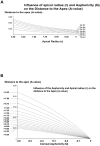Corneal elevation topography: best fit sphere, elevation distance, asphericity, toricity, and clinical implications
- PMID: 21107250
- PMCID: PMC4142625
- DOI: 10.1097/ICO.0b013e3181fb4fa7
Corneal elevation topography: best fit sphere, elevation distance, asphericity, toricity, and clinical implications
Abstract
Purpose: To describe the effect of the corneal asphericity and toricity on the map patterns and best fit sphere (BFS) characteristics in elevation topography.
Methods: The corneal surface was modeled as a biconic surface of principal radii and asphericity values of r1 and r2 and Q1 and Q2, respectively. The apex of the biconic surface corresponded to the origin of a polar coordinates system. Minimization of the squared residuals was used to calculate the values of the radii of the BFSs and apex distance (A-values: z distance between the corneal apex and the BFS) of the modeled corneal surface for various configurations relating to commonly clinically measured values of apical radius, asphericity, and toricity.
Results: Increased apical radius of curvature and increased prolateness (negative asphericity) led to an increase in BFS radius but had opposite effects on the A-value. Increased prolateness resulted in increased BFS radius and A-value. Increasing toricity did not alter these findings. Color-plot elevation maps of the modeled corneal surface showed complete ridge patterns when toricity was increased and showed incomplete ridge and island patterns when prolateness was increased.
Conclusions: High A-values in patients with corneal astigmatism may result from steep apical curvature and/or high prolateness (negative asphericity). The BFS radius may help in distinguishing between these 2 causes of increased A-values. Increased prolateness and decreased apical radius of curvature (often seen in keratoconus) have opposite effects on the BFS radius but similar effects on the apex distance.
Figures






Similar articles
-
[A review of mathematical descriptors of corneal asphericity].J Fr Ophtalmol. 2002 Jan;25(1):81-90. J Fr Ophtalmol. 2002. PMID: 11965125 Review. French.
-
Comparison of and correlation between anterior and posterior corneal elevation maps in normal eyes and keratoconus-suspect eyes.J Cataract Refract Surg. 2008 May;34(5):789-95. doi: 10.1016/j.jcrs.2007.12.036. J Cataract Refract Surg. 2008. PMID: 18471634
-
Corneal asphericity change after excimer laser hyperopic surgery: theoretical effects on corneal profiles and corresponding Zernike expansions.Invest Ophthalmol Vis Sci. 2004 May;45(5):1349-59. doi: 10.1167/iovs.03-0753. Invest Ophthalmol Vis Sci. 2004. PMID: 15111588
-
Effect of Corneal Tilt on the Determination of Asphericity.Sensors (Basel). 2021 Nov 17;21(22):7636. doi: 10.3390/s21227636. Sensors (Basel). 2021. PMID: 34833714 Free PMC article.
-
Corneal asphericity and spherical aberration.J Refract Surg. 2007 May;23(5):505-14. doi: 10.3928/1081-597X-20070501-15. J Refract Surg. 2007. PMID: 17523514 Review.
Cited by
-
Wound healing after keratorefractive surgery: review of biological and optical considerations.Cornea. 2012 Nov;31 Suppl 1(0 1):S9-19. doi: 10.1097/ICO.0b013e31826ab0a7. Cornea. 2012. PMID: 23038040 Free PMC article. Review.
-
Limbus misrepresentation in parametric eye models.PLoS One. 2020 Sep 24;15(9):e0236096. doi: 10.1371/journal.pone.0236096. eCollection 2020. PLoS One. 2020. PMID: 32970690 Free PMC article.
-
Human rather than ape-like orbital morphology allows much greater lateral visual field expansion with eye abduction.Sci Rep. 2015 Jul 20;5:12437. doi: 10.1038/srep12437. Sci Rep. 2015. PMID: 26190625 Free PMC article.
-
The Sclerotic Scatter Limbal Arc Is More Easily Elicited under Mesopic Rather Than Photopic Conditions.PLoS One. 2016 Mar 10;11(3):e0150314. doi: 10.1371/journal.pone.0150314. eCollection 2016. PLoS One. 2016. PMID: 26964096 Free PMC article. Clinical Trial.
-
Target specification and therapeutic potential of extracellular vesicles for regulating corneal angiogenesis, lymphangiogenesis, and nerve repair.Ocul Surf. 2024 Oct;34:459-476. doi: 10.1016/j.jtos.2024.10.005. Epub 2024 Oct 18. Ocul Surf. 2024. PMID: 39426677 Review.
References
-
- Cairns G, McGhee CN. Orbscan computerized topography: attributes, applications, and limitations. J Cataract Refract Surg. 2005;31:205–220. - PubMed
-
- Holland SP, Srivannaboon S, Reinstein DZ. Avoiding serious corneal complications of laser assisted in situ keratomileusis and photorefractive keratectomy. Ophthalmology. 2000;107(4):640–52. - PubMed
-
- Kohnen T. Iatrogenic keratectasia: current knowledge, current measurements. J Cataract Refract Surg. 2002;28(12):2065–6. - PubMed
-
- Faraj HG, Gatinel D, Chastang PJ, Hoang-Xuan T. Corneal ectasia after LASIK. J Cataract Refract Surg. 2003;29(1):220. - PubMed
-
- Randleman JB, Russell B, Ward MA, Thompson KP, Stulting RD. Risk factors and prognosis for corneal ectasia after LASIK. Ophthalmology. 2003;110(2):267–75. - PubMed
Publication types
MeSH terms
Grants and funding
LinkOut - more resources
Full Text Sources
Other Literature Sources
Medical
Miscellaneous

